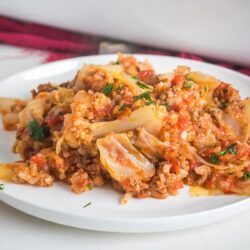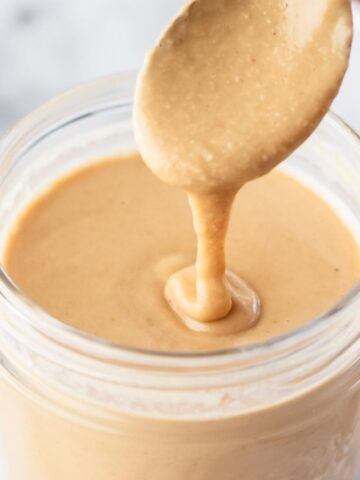Stuffed Cabbage Rolls are a classic comfort food dish that consists of cabbage leaves filled with beef, pork, and rice covered in homemade sauce.

These pockets of deliciousness can be served as is or over a bed of rice or cooked cabbage. Don’t feel like rolling the cabbage up?

Try our Cabbage Roll Casserole, where we use chopped cabbage that’s steamed but still just as delicious.

Ingredients for stuffed cabbage rolls
- Green Cabbage – Do not use red cabbage for this. We get a medium to large size head of cabbage for this recipe.
- Olive Oil – This is to cook the onions and garlic.
- Onion – If you don’t like onions, you can omit them, but they give this recipe a delicious flavor.
- Garlic – We suggest using fresh garlic, but you can also use refrigerated peeled garlic. We don’t recommend jarred garlic.
- Ground Beef & Ground Pork – We use a combination of beef and pork for our cabbage rolls but you can use all ground beef if you prefer. Some even used ground sausage for added flavor.
- Rice – You can use par-cooked rice or leftover refrigerated rice.
- Parsley – We use parsley to give a pop of color and flavor.
- Salt & Pepper – Use to taste. We typically use Kosher salt in most recipes.
- Egg – This helps keep everything together.
- Crushed Tomatoes and Tomato Sauce – We make a scratch sauce for our cabbage rolls.
- Brown Sugar – You can use less or more depending on your sweetness preference or leave it out altogether.
- Red Wine Vinegar – We use some vinegar to add a little tang. You can omit it if you like.

How to make Stuffed Cabbage Rolls
Start by making the tomato sauce. Add olive oil to a medium-sized saucepan over medium heat. We then add in the onions and cook until they’re translucent, and then add in the garlic and cook for another minute.

Then, you can pour the tomatoes with juice, tomato sauce, brown sugar, vinegar, and salt and pepper to taste. Let the sauce simmer on low for 15-20 minutes while you prep the cabbage rolls.

Core the cabbage and place it into a large pot with a steamer basket in the bottom. Pour in 1-2 inches of water and steam the cabbage until the leaves can be easily removed. Use caution when handling it, allowing it to cool until cool enough to handle.

Place the cabbage leaf onto a cutting board and use a pairing knife to cut a V to remove the rib. This will make the leaves more pliable and easy to stuff.

Preheat the oven, add one tablespoon of olive oil to a skillet, and brown the onion for 5 minutes. Add in the garlic and cook for an additional minute.

Place the cooked onion, garlic, cooked rice, ground meat, salt, pepper, parsley, and egg into a mixing bowl. Add a ladle full of the prepared tomato sauce to the mixture and then combine.


On a cutting board lay the cabbage leaves flat and then place a heaping cookie scoop of meat into the leaf. Roll it up and tuck in the ends. Repeat with remaining cabbage leaves and meat mixture.


Pour half of the sauce into the bottom of a 9×13 baking dish and then place the cabbage rolls on top of the sauce seam side down. Next pour the other half of the sauce on top of the cabbage rolls.


Bake the cabbage rolls covered for 75-90 minutes. The ground meat temperature should be atleast 160 degrees F.

Recipe Tips and Alterations:
- Have leftover pieces of cabbage? I love to add that to the sauce. It gives it more texture and, of course, no waste!
- You can alter the meat mixture to your liking. You can do all beef, all pork, ground chicken, ground turkey, or even impossible ground meat would work.
- If you want even more sweetness, you could even add raisins.
- Cutting a V into the bottom of the cabbage to remove the tough rib allows you to stuff the cabbage and roll it up easily.
- Short on time? Try out our lazy cabbage roll casserole.

Storage and reheating tips:
- Refrigerate: Store any stuffed cabbage roll leftovers in an air-tight container in the refrigerator and enjoy within 3-4 days.
- Freeze: To freeze cooked stuffed cabbage rolls, place them in an airtight freezer-safe container and freeze. For the best quality, enjoy within 3-4 months. To freeze uncooked, you can freeze the cabbage rolls in a container without the sauce or a foil pan with the sauce. Since they’re frozen and raw, you must add 20-25 minutes to the cooking time.
- Reheat: You can use your oven or microwave to reheat stuffed cabbage. The microwave isn’t as consistent to reheat. You can bake them in a 350 degrees F oven in a baking dish with leftover sauce and a few tablespoons of broth or water. Cover and bake for 15-20 minutes until hot throughout.

How to serve stuffed cabbage rolls
We like serving stuffed cabbage rolls with a bed of rice and a quick tomato cucumber salad. We also love cabbage rolls over mashed potatoes too.
Frequently Asked Questions
Yes, you can prep everything early in the afternoon and then cover and refrigerate (up to 8 hours) until ready to bake. Once ready place everything into a baking dish and bake per the directions below. Please do not use a cold baking dish in the oven, as it may shatter.
Don’t wrap them too tightly; remember to place them seam-side down in the casserole dish.
Yes! Cabbage rolls are a labor of love. They are worth all the time involved, but I will usually double or triple the batch to freeze in batches.
Find more cabbage recipes

Stuffed Cabbage Rolls
(click stars to vote)
Print Pin SaveIngredients
Cabbage Rolls
- 1 head green cabbage
- 1 tablespoon olive oil
- 1 cup onion finely diced
- 2 cloves garlic minced
- 1 pound ground beef
- 1/2 pound ground pork
- 1 cup par-cooked rice cook rice 3-4 minutes less than directions, you could also use cold leftover rice
- 1/4 cup parsley freshly chopped
- 1 teaspoon salt
- 1/2 teaspoon pepper
- 1 egg
Tomato Sauce
- 1 tablespoon olive oil
- 1/2 cup onion chopped finely
- 3 cloves garlic minced
- 28 oz can crushed tomatoes with juice
- 15 oz can tomato sauce
- 1-2 tablespoons brown sugar optional for added sweetness, to taste
- 1-2 tablespoons red wine vinegar or 1 lemon juiced
- salt and pepper to taste
Instructions
Tomato Sauce
- Add the olive oil to a medium-sized saucepan and heat over medium heat. Add the onions and cook until translucent, about 5 minutes. Add the garlic and cook for another minute.
- Pour the tomatoes with juice, tomato sauce, brown sugar, vinegar, and salt and pepper to taste. Mix and bring to a simmer. Cook on simmer for 15-20 minutes.
Cabbage Rolls
- Core the head of the cabbage. Place the cored head of cabbage in a large pot with a large steamer basket at the bottom. Add about 1-2 inches of water. Steam the cabbage head until the outer leaves are easy to remove. Careful not to burn yourself. Remove the leaves as they become soft and can easily be removed from the head of the cabbage. If you want to boil the cabbage, bring a large pot of salted water to a boil. Boil the cabbage for 4-5 minutes until the leaves are softened, and remove the soft leaves. Don’t overcook, they will cook further in the oven.
- Place the cabbage leaf onto a cutting board and use a pairing knife and cut a V to remove the rib and make the leaves more pliable. Set aside.
- Preheat the oven to 350 degrees F.
- Add 1 tablespoon of olive oil to a skillet and brown the onion for 5 minutes. Add in the garlic and cook an additional minute.
- Place the cooked onion, cooked garlic, cooked rice, ground beef, pork, salt, pepper, parsley, and egg in a mixing bowl. Add a ladle full of the prepared tomato sauce to the mixture and combine.
- On a clean surface lay the cabbage leaves flat. Place a heaping cookie scoop of meat into the cabbage leaves and roll up, tucking in the ends. Repeat with remaining cabbage leaves and meat mixture.
- Pour half of the tomato sauce into the bottom of a 9×13 baking dish. Place the cabbage rolls on top of the sauce, seam side down, and pour the remainder of the tomato sauce onto the cabbage rolls.
- Cover the baking dish with foil. Bake for 75-90 minutes. For food safety, ground meat should be cooked to 160 degrees F.
Notes
Nutrition
The nutritional information is automatically calculated and can vary based ingredients and products used. If the nutrition numbers are important for you we recommend calculating them yourself.
















Leave a Reply